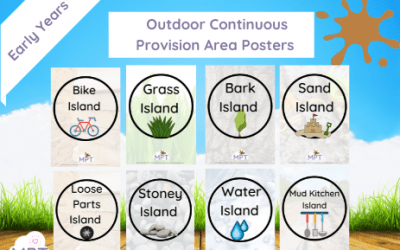The MPT Prospectus What does this resource include? 1 x 27-page PDF document explaining the services w have at MPT...
EYFS&KS1: Autumn Outdoor Continuous Provision
Oct 18, 2022
What does this pack include? 1 Vlog giving you tips on how you can use leaves in autumn for outdoor continuous...
Muddy Lanyard Challenges Numbers 1- 20
May 4, 2022
Our much-loved Muddy Lanyard Challenges are very popular and a versatile tool to use outdoors, give direction and in...
Numbers in Leaves (Tuff Spot/Display)
May 4, 2022
Time to make early years outdoors a little easier for yourself? These cards are great to give direction for tuff...
Baby first nature experience cards
Apr 26, 2022
Baby first nature experience cards this a great nature-based flashcard set. Choose one card every week to experience...
Capital Letters in Rocks
Apr 26, 2022
Capital Letters in Rocks this a great nature-based poster set to display in the continuous provision or you could use...
Capital Letters in Leaves
Apr 26, 2022
Capital Letters in Leaves is a super popular resource of ours that could be used in outdoor continuous provision or...
Nature Easter Eggs Template
Apr 7, 2022
Use Nature Easter Eggs to enhance your outdoor learning, find more outdoor learning resources under your year group...
Muddy Hands Bags (Maths)
Mar 28, 2022
Time to get those little hands muddy with these innovative ideas for great fine and gross motor practice.
Forest School Session Plan – Brilliant Bugs
Mar 28, 2022
Forest School the Muddy Way! Use some of our Forest School resources to help us do the work so you get to play! Use...
Forest School Rules Poster
Mar 28, 2022
We make Forest Schools easier for you by doing all the work for you so you can make more of the FUN! Use this poster...
Outdoor Lanyard Challenges (Independence Skills)
Mar 23, 2022
Use Outdoor Lanyard Challenges to get more independent skills outside. These easy to use resources make a great...
Muddy Kitchen (Themed Posters)
Mar 18, 2022
Try some of our resources for Free. Sign up to our free outdoor learning membership here.
Outdoor Continuous Provision Area Posters
Mar 18, 2022
Wow! Let us help you organise your outdoor area with these amazing downloadable posters. Laminate and display outside...
Nature Sunflowers (Art Task)
Mar 8, 2022
Use this fantastic resource to create some Nature Sunflowers (Art Task). The children use natural resources and this...
Muddy Fingers Workout Activity
Mar 8, 2022
Use these amazing outdoor worksheets to gibe those tiny Muddy Fingers a Workout! Early Years Outdoor learning for...
Pebble Mat (Tuff Spot) Set One Phase Two Phonics
Mar 7, 2022
Use Pebble Mat (Tuff Spot) Set One Phase Two Phonics to get some quality and rich phonics learning happening outside...
How to make a Nature Caterpillar (Tuff Spot)
Mar 7, 2022
Such a simple but much-loved activity. Children follow the instructions as they make their very own Nature...
New In

Whirlpool Lesson Ideas – SEND Pack

Tornado Lesson Pack for SEND

All About Me Lesson Ideas

Lunar New Year Outdoor Arts Pack

Bottle Greenhouse Instructions

Blank Outdoor Lanyard Template

Outdoor Learning Assessment Grid

Nelson Mandela KS1 (Outdoor Lesson Ideas)

Rosa Parcs (KS1) Outdoor Lesson Ideas




















